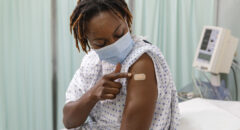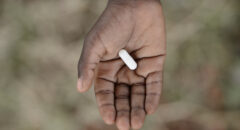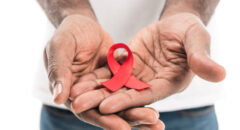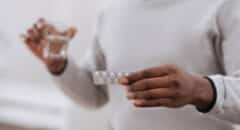 (BlackDoctor.org) – AIDS. It’s still here. It’s still strong. Our community is still suffering. Our community is still dying. This means we have to keep fighting.
(BlackDoctor.org) – AIDS. It’s still here. It’s still strong. Our community is still suffering. Our community is still dying. This means we have to keep fighting.
• According to the CDC, Blacks account for about 52% of all new HIV cases and 48% of AIDS diagnoses in the US.
• Among all women in the United States diagnosed with AIDS in 2008, 77% were Black women.
• Among ages 25-34, AIDS is the leading cause of death for Black women.
• AIDS is the fourth leading cause of death for Black men between the ages of 25-44.
AIDS 1981
Imagine the worst kind of wake-up call: You’re slated to die, and no authority has the power, much less the competence, to commute your sentence.
Since 1981, far too many Americans have received such a summons. In June of that year, the Centers for Disease Control and Prevention (CDC) disclosed a baffling rare pneumonia in five gay men in Los Angeles–the first recorded cases of what would eventually become known as AIDS. Since then, 1.7 million Americans have become infected with HIV (pdf). More than 1 million Americans currently live with the virus, including some 500,000 Black Americans (pdf), who have been infected disproportionately since the onset.
Our nation is approaching AIDS’ 30th birthday, a dark commemoration that will induce many people to assess their unsentimental journey through the AIDS pandemic. Here, three African Americans reflect on their experiences.
A Strong Painkiller of Silence
“In 1985 I was incarcerated in South Carolina Women’s Correctional Institution,” says Pat Kelly. Her offense–writing bad checks–cost her only a short time behind bars. Yet Kelly recalls almost four weeks of isolation in lockdown awaiting results of a compulsory blood analysis. Finally a doctor was standing before her. “He was wearing a mask, gloves and a gown,” Kelly recalls. “He just said I had AIDS and was going to die.”
The doctor then prescribed a strong painkiller: silence. He warned Kelly to tell nobody or else nobody would go near her.
Kelly was released about nine months later, knowing little about HIV/AIDS. “Only what I had seen on TV,” she says, including a report that people with AIDS would be dead within three years.”
But fact was, the jailhouse doc’s prognosis hit home. “Every time I got a cold, every time this happened, every time that happened,” Kelly says, “I thought it was time for me to go.” And thinking she was going to die, Kelly lived in the fast lane: “I was just like, if I’m going out, I’m going out with a bang.”
Kelly’s one early attempt at counseling included only one session companion, another woman, whose tales of social stigma and the adverse effects of treatment terrified her. “She told me about how her hair fell out,” Kelly recalls. “Just hearing her horror stories, I was, like, oh no! I ain’t never taking that medicine.” And so, resigned to dying, Kelly waited for AIDS to summon her.
Today Kelly has prevailed over her doctor’s grim prognosis and her worst fears of 25 years ago. “It took me nine years before I joined a support group,” admits Kelly, who says that she came around to taking medication in 1998. She now directs Life After the Sign, an HIV/AIDS support group in Orangeburg, S.C., where her survival and hard-won expertise enable her to counsel women who are going through what she did.
Fighting the 4H Stigma
While Kelly needed time to rally, others fought back almost immediately.
“I don’t know if you remember that the CDC had identified people at risk as the ‘four Hs,’ ” says Jean Claude Compas, M.D., a Haitian family-practice physician in Brooklyn, N.Y. “It stood for “Haitians, hemophiliacs, homosexuals and heroin addicts.”
When, in 1983, the CDC recommended banning the “4H” groups from donating blood, it cast a social stigma over the Haitian community.
“Scientifically, it didn’t make any sense,” Dr. Compas says of the ban. Despite New York City health officials lifting Haitians from its own 4H high-risk group in 1983, federal agencies continued to bar them from blood drives for eight more years.
On April 20, 1990, when the U.S. ban was up for review, about 70,000 Haitian New Yorkers marched across the Brooklyn Bridge into lower Manhattan to protest what Dr. Compas calls the “terrible stigma” that was demonizing Haitian blood.
“The protest was very important for us,” says Dr. Compas, who was a key organizer of the march. Today, he finds, “the stigma of AIDS is less, but still there,” so the task of educating his community about prevention and treatment remains urgent.
Breaking a Blanket Curse
Of course, one of the 4Hs was homosexuals. While a teenager in Topeka, Kan., Tod Roulette struggled with his budding sexuality and, like most youths, tried to express himself in other ways.
Roulette had his heart set on going to a minority journalism camp, “but my mother was married to a fundamentalist Pentecostal preacher, who thought it wouldn’t serve any purpose,” he recalls.
When Roulette’s parents refused to let him go, another Pentecostal preacher–seemingly more open-minded and accepting than Roulette’s parents–admonished them not to stand in the way of the boy’s future. “This pastor really took it upon himself,” Roulette remembers. At last, he thought, he had found someone he could confide in about his sexuality.
During a car ride with the pastor, Roulette was just about to share his secret that he was gay when the preacher reached over and tuned in to National Public Radio. “This was 1984,” Roulette says, “and NPR had on a segment about ‘gay cancer,’ ” as AIDS was sometimes referred to back then. Suddenly his seemingly liberal benefactor blurted out, ‘All those homosexuals are going to die and go to hell.'”
Roulette rode out the rest of the trip in silence. He felt as if the preacher’s blanket curse was still hanging over him when he was diagnosed as HIV positive eight years later, in 1992. So he worked on breaking its spell by writing publicly about his status.
Today Roulette concedes that the devastating impact of the 30-year AIDS crisis on the Black community has cooled the burning coals that many fundamentalist preachers used to hurl from the pulpit. But he still believes that their anti-gay ire is misdirected.
When churches spend their energies and resources opposing issues like homosexual marriage and gay adoption, they miss the opportunity to rally together to help people, says Roulette, who today is a churchgoing (now Episcopal) adoptive parent living in Harlem, N.Y. He says that church leaders should take on AIDS education “because obviously, if all these kids are being born out of wedlock, [their parents] aren’t having protected sex.”
Despite the pandemic’s bleak history, even its unresolved future is brighter. Now I’m 43, but I didn’t think I’d live past 35,” says Roulette, who became an art dealer. “Hopefully we’re not going to have a 60-year anniversary of AIDS.”
Even after 30 years of heartbreaking tales like the ones above, the facts of HIV/AIDS prevention are still the same:
Be Aware. Get Tested. Use Protection.








